#Turkey’s Ancient City Of Gladiators
Photo
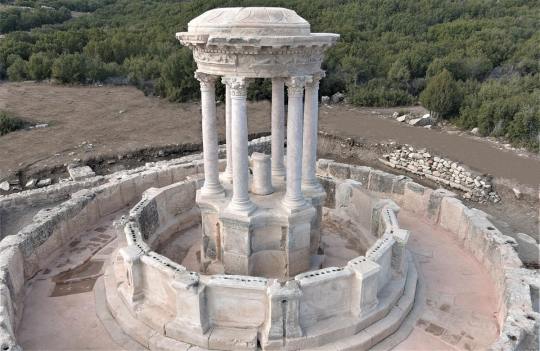





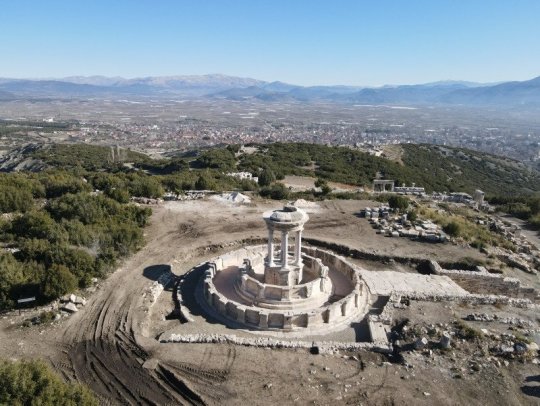
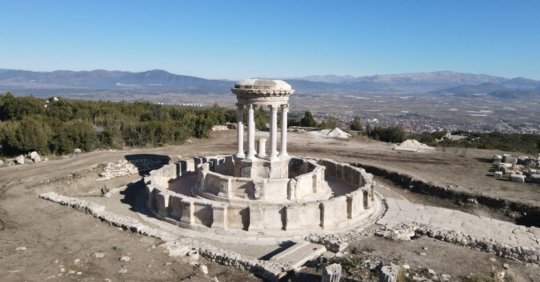
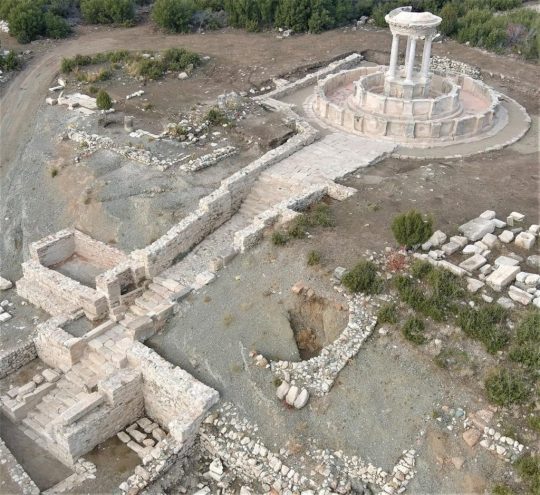
City of Gladiators Fountain Flows Again After 2,000-Years in Turkey
An ancient fountain that was destroyed in a 23 BC earthquake has been restored in Turkey's “City of Gladiators.' Now, the two millennia old water font is streaming drinkable water again, just as it did some 2,000-years ago.
Unearthing Turkey’s Ancient City Of Gladiators
The ancient city of Kibyra, or Cibyra Magna, is situated in the township of Gölhisar in the southwestern Burdur Province of Turkey. In ancient times it represented the capital city of an independent state known as Cibyratis, that lay just outside the north-western limits of the ancient province of Lycia, that thrived in Anatolia from 15-14th centuries BC, and as Lukka until 546 BC.
Strabo recorded Kibyra as having originally been settled by ‘Lydians,’ who were indigenous people in this region of Asia Minor. These people constructed over 100 stadiums and after the Roman general Lucius Licinius Murena defeated the ruler of Kibrya in 83 BC the city became part of the greater Roman province of Asia. Listed on the UNESCO World Heritage Tentative List , ancient Kibyra is known as the “City of Gladiators.” Now, archaeologists have announced that “a colossal fountain” has been restored and that it will “flow with fresh water for the first time in 2,000 years.”
Piecing Together An Ancient Masterpiece
Dr. Sukru Ozudogru, an archaeologist at Mehmet Akif Ersoy University, recently told Anadolu Agency ( AA) that his team of archaeologists have spent the past four months collecting “150 original fragments from the ruins.” Now, they have successfully “pieced the architectural masterpiece back together.” The “round-planned fountain” measures 15.24 meters (50 ft) in diameter by 7.92 (26 ft) high and after being built it was used for more than 600 years.
The team of archaeologists have also restored the original water supply system from the spring, so that the fountain now flows with drinkable water “just the way it did 2,000 years ago.”
Dr. Ozudogru described the water from the restored fountain as “spouting from the mouths of lion and panther.” Not only do these two animals feature heavily in Roman mythology but they are two of the animals that gladiators fought in the arenas. Incidentally, it was after the discovery of the “10,400-person stadium” that hosted hundreds of gladiatorial fights that Kibyra became known as the “City of Gladiators.”
Rebuilding What Nature Attempted To Destroy
Blending both Roman and Byzantine architectural styles, during the 1000 years of the Roman empire the city became famous for its blood-thirsty gladiatorial contests. However, a 23 BC earthquake almost flattened Kiybra, and if it were not for diligent citizens in the aftermath rebuilding the giant fountain it would have been lost in time long ago.
The AA article said the restoration of the fountain and its two pools required “68 original architectural pieces and 24 imitation blocks produced from the original stone type.” Furthermore, it was observed that the original fountain featured one large circular pool and the second pool was added decades later. Dr. Ozudogru maintains that when the fountain was functional, some 2,000-years-ago, the two circular pools supplied potable water to four different parts of the city.
Sticking With The Original Plan
As far as aesthetics are concerned, fragmentary remains informed the researchers the original fountain was detailed with “elaborate statues of animals, huge columns and embossed friezes.” The archaeologists used two moldings taken from original sculptures that were both unearthed during recent excavations, and the originals are currently being exhibited in the Burdur Museum.
The researcher explained that in Roman times “Water was a mythological hero” that flowed into the two pools from the mouths of “lion and panther” statues. Relating these two animals to Roman mythology “ Heracles lay on a panther skin and Dionysus, the god of wine, wore a lion skin," according to the professor. However, both of these animals were fought by gladiators in the 10,400-person stadium in Kibrya, which Akkurnaz explained “was a building designed for an assortment of blood-soaked spectacles, including gladiator fights and wild animal fights”.
By Ashley Cowie.
#City of Gladiators Fountain Flows Again After 2000-Years in Turkey#Turkey’s Ancient City Of Gladiators#ancient city of Kibyra#ancient monument#ancient fountain#ancient artifacts#archeology#archeolgst#history#history news#ancient history#ancient culture#ancient civilizations#roman history#roman empire#long reads
71 notes
·
View notes
Text
spectacular Roman fountain has risen from the rubble in ancient Kibra, Anatolia to once again flow with fresh drinkable water, as it once did 2,000 years ago.
67 notes
·
View notes
Text
9 notes
·
View notes
Text
Explore the Enchanting Historical Sites of Ephesus, Turkey: Center of Gladiator Battles!
Hey Tumblr fam! 👋 Looking to embark on an awe-inspiring journey through history? Look no further than the magnificent city of Ephesus in Turkey! 🏛️✨ Brace yourselves for an unforgettable adventure as we step back in time and unravel the secrets of this ancient wonder. 🗺️✨

🌟 Discover the Glory of Gladiator Battles 🌟
Step into the amphitheater of Ephesus, where epic gladiator battles once unfolded. Imagine the roar of the crowd as brave warriors clashed swords, displaying their valor and skill. Feel the palpable energy that still lingers in the air and let your imagination transport you to a bygone era of bravery and spectacle. 🗡️⚔️
🏛️ Uncover Architectural Marvels 🏛️
Prepare to be mesmerized by the architectural brilliance of the ruins in Ephesus. Wander through the ancient streets lined with majestic columns, trace the footsteps of the Romans, and marvel at the well-preserved structures that tell tales of the city's rich past. From the awe-inspiring Library of Celsus to the grand Theater, every corner exudes a sense of grandeur and whispers stories of ancient civilizations. 📜🏛️
Read full Blog from the link given below:
💫 Visit the Temple of Artemis 💫
No trip to Ephesus would be complete without visiting the legendary Temple of Artemis, one of the Seven Wonders of the Ancient World. Bask in the presence of this majestic sanctuary dedicated to the Greek goddess of the hunt. Let the remnants of this colossal structure ignite your imagination and transport you to a time when gods and goddesses were worshipped with utmost devotion. 🏹🌸
🍽️ Delight in Culinary Adventures 🍽️
After immersing yourself in history, take a break to indulge in the delightful Turkish cuisine. Savor the aromatic flavors of kebabs, dolmas, and traditional desserts, tantalizing your taste buds with the richness of Turkish culinary delights. Let your exploration extend beyond ancient ruins as you discover the vibrant local markets and savor the culinary treasures that Ephesus has to offer. 🍽️🌶️
✨ The Time is Now! Embark on Your Journey to Ephesus! ✨
Unearth the magic of Ephesus and let its historical sites transport you to a realm of wonder and adventure. Book your tickets, pack your bags, and get ready for an extraordinary experience that will leave you in awe. Whether you're a history buff or simply seeking a unique travel experience, Ephesus promises to enchant you with its timeless allure. ✈️🗺️
Remember to check out my full blog post here for more in-depth details, insider tips, and breathtaking photos! 📷✨
#Ephesus#Turkey#TravelDiaries#HistoryUnveiled#ArchitecturalMarvels#TempleOfArtemis#CulinaryAdventures#AncientWonders#BucketListDestination#UnleashTheExplorerWithin
0 notes
Text
Fountain that stood in Turkey's ancient 'City of Gladiators' 2,000 years ago has been restored
Fountain that stood in Turkey’s ancient ‘City of Gladiators’ 2,000 years ago has been restored
A colossal fountain that once stood in the ancient ‘City of Gladiators’ has been restored and will flow with fresh water for the first time in 2,000 years.
An excavation team has been working in the city of Kibyra in Turkey for the past four months, collecting 150 original fragments from the ruins in the area to piece the architectural masterpiece back together.
Sukru Ozudogru, an archaeologist…

View On WordPress
0 notes
Text
Rare gladiator tombs found in ancient city in southern Türkiye
By Daily Sabah

Photo Credit: AA
Archaeologists discovered gladiator tombs at the ancient city of Anavarza in Türkiye’s southern Adana province.
Anavarza, which made it to UNESCO’s Tentative List of World Heritage in 2014, is home to past civilizations, including the ancient Greek, Roman, Byzantium, Sassanid, and Ottoman empires.
The excavation team, which includes 24 staff, 30 scientists and two archaeologists led by Dr. Fatih Gülşen from Çukurova University, has been carrying out excavations at the site near the amphitheater and the theater sections this season, Anadolu Agency (AA) reported.

Photo Credit: AA
Noting that they found the tombs near the southern part of the excavation site, close to the amphitheater, Gülşen said they believe the gladiators fought here.
“We know that they organized not only gladiator fights but also water sports, games, and festivals here,” Gülşen said, as he noted that the amphitheater at Anavarza is one of the four such examples in Anatolia.
Gülşen noted that they expected to discover the bones of gladiators and a necropolis in their excavations and shed light on the history of the ancient site.

Photo Credit: AA
Since excavations at the site began in 2014, researchers have discovered limestone statues of the Greek goddess Hygieia and god Eros along with several mosaics and relics.
The city also features the world’s first and oldest street, a 2,700-meter-long and 34-meter-wide road decorated with 1.5-meter-high columns.
The Anavarza castle sits on top of a central hill in the area, overlooking the vast and fertile Çukurova plain once known as Cilicia, and is regarded to be among the most important ancient castles in Turkey.
Source: https://www.dailysabah.com/life/history/rare-gladiator-tombs-found-in-ancient-city-in-southern-turkiye
0 notes
Text
Antalya- Roman Ruins & Waterfalls
For our last full day in Turkey I wanted to see something new. I booked us a full day tour to visit some ruins and see a famous local waterfall. Our guide was meeehhhh not our favorite but he was very knowledgeable and the people on our tour were great “okay” as well. Overall, the tour was a bit of a bore BUT without the tour we would never have been able to see the cool things we did. We stopped at four different locations beginning with an ancient Roman city, then moving to a very well preserved theater, to a beautiful beach side town, finishing with a natural waterfall! It was a LONG day but it was a good day. Here are some of my notes and photos! In my opinion, this was a great way to finished Turkey!!
First Stop- Perge
- Perge is one of the most popular historical sites along the Antalya region. Being an ancient Greek city, Perge is famous for its Roman ruins dating back to 1300 BC and its big amphitheater with a capacity of 15,000 people.
* Has a 2000-year-old history and magnificence.
* One of the largest ancient settlements that have survived as a whole.
* One of the most important sculpture production centers of the ancient times.
* Had the most brilliant years during the Roman times on the 2nd and 3rd century AD.
* Has a great level in urban planning.
* Was an important settlement for the history of Christianity, where the Saint Paul have visited the city so many times.

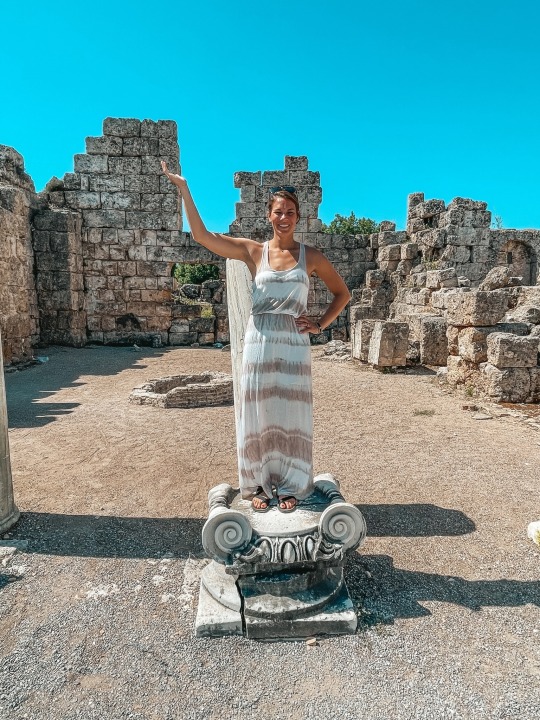

Second Stop- Aspendos
- [ ] This is a Roman theater
- [ ] There are more than 30O Roman theaters in the area and Aspendos is one of the most well preserved theaters
- [ ] An amphitheater is a full circular theater with performances in the center where as a “theater” is a half circle theater with a stage and an audience viewing from the front.
- [ ] The building was built in 140-150AD
- [ ] The theater olds around 13,000 people
- [ ] The theater was used for animal or gladiator fighting
- [ ] 86-88% original




Third Stop- Side
- [ ] “Side” means pomegranate and it the symbol of fertility
- [ ] This is a port city in Antalya off the Mediterranean Sea
- [ ] The new city is built on top of the old city


Fourth Stop- Kursunlu Waterfall Natural Park
- [ ] Natural waterfall

0 notes
Photo


2020 October 29 - Aphrodisias
#travel#turkey#ancient city#city#ancient rome#ancient world#ruins#unesco#unesco world heritage site#world heritage site#theater#stadium#ancient stadium#sports#games#races#gladiators#ancient games#panorama#blood sports#archaeological site#archaeology#aphrodisias
0 notes
Text
Gladiator arena from Roman era unearthed in Turkey

Archaeologists in Turkey have discovered the remains of a "magnificent" Roman-era arena, where up to 20,000 spectators likely cheered and jeered as they watched gladiator matches and wild animal fights, the excavators said.
The 1,800-year-old arena was discovered on the rolling hills of the ancient city of Mastaura, in Turkey's western Aydın Province. Its large central area, where "bloody shows" once took place, has since filled with earth and vegetation over the centuries.
"Most of the amphitheater is under the ground," and the part that is visible is largely covered by "shrubs and wild trees," Mehmet Umut Tuncer, the Aydın Culture and Tourism provincial director and project survey leader Sedat Akkurnaz, an archaeologist at Adnan Menderes University in Turkey, told Live Science in a translated email. Read more.
392 notes
·
View notes
Note
Hello! ¡Hola! Ciao! Salut ! So question: what would you do if you ever met Gilbert, Lovi and Arthur in real life? And possibly where would be the location of your meeting? 🙃
Dear Ancients are you trying to kill me? @_@
Salutations, Lovely~ I'll try to be as... realistic as I can here, I guess.
First off, I at least know from experience that I would keep my panic at bay until I was finally alone again, when I would have a full on meltdown. I don't-
How do you cope with meeting someone you've been lowkey daydreaming about for the past ten years? Silently vow to yourself to keep calm and carry the fuck on, and make sure you never let them find out that you've been writing fanfiction about them for near a decade.
As for how I would meet them?
Well, that's honestly a really hard one to answer, luv. ^_^; Despite my severe social anxiety, I casually befriend people all the time, in some of the most unpredictable ways.
I based each of these loosely off of how I actually met some of my friends, as realistically I can't even begin to narrow down just how I meet/befriend people.
Arthur I know would be the most likely candidate for actually, unintentionally running into. My ultimate goal for years has been to move back to London on a permanent basis, hopefully earn my Masters equivalent in History or Journalism. Now, I gotta be honest, I was rarely ever in my dorm except to sleep; there was a whole city to see!
I got roped into a giant game of Manhunt in Southwark with a bunch of (at that time) strangers, I wandered the damp silt along the Thames when the tide was low, bonding with some Crawlers over the cool ass artifacts we found, and there was Brazilian student I became Whats App buddies with during a weekend bus trip to Belgium, bonding over our books, the fact we were the only singles in a tour group filled with couples, and everything we thought the other should explore back in London.
I can honestly say that Arthur is... Welp, I just think out of the three of them, however we meet would be the most random happenstance. Maybe he's the punk I bonded with while in the queue outside Garfunkle's, singing along to the vintage tunes and gradually loosening up into overly dramatic faces and silly dances.
Gilbert would... As much as I love him, I feel like in real life he would probably intimidate me at first.
He reminds me of these guys I met in Montmartre that started walking with me, rambling at me in French, then English, trying their damndest to convince me to let them buy me a coffee. I thought I was in the clear when I used Italian to say I didn't understand what they were saying, and my fucking luck that one of them was fluent in Italian, too. Or maybe he's like the guy who was at the Venice airport waiting for the same flight, bored out of his mind and playing wallball with a small bouncy ball he had in his pocket, who I ended up asking to join when my roommate fell asleep on her then-boyfriend, now-husband. Or he'd be like the kid who accidentally got locked into Regent's Park after hours, and I helped him climb over the fence to get back out. Or maybe he's the guy I made laugh in an Amsterdam grocery store because of my mini meltdown over finally finding Cool American Doritos at 10 pm, who then helped me figure out exactly which pre-sliced deli meat was turkey-esque.
The thing with Gil is that he's such an extrovert that I could see him being the one more likely initiating any possible friendships.
And then there's Lovino.
If he were true to canon, he's more than likely the one approaching me. Maybe he's the guy who rescued me in Rome from the tourist trap gladiator actors, who will gladly take pictures with you, but don't tell you till after that you're suppose to pay them for each photo. Or maybe he's the guy from the flight to Roma, who was on the phone before takeoff cursing lowly in Italian about politics, and for my dumbass and smart mouth to immediately start commiserating with him, the next hour and a half spent venting to each other about our nations' mutually terrible politicians, and the woes of living in the hellishly expensive London. Or, or! Lovi could be the man I saw in the Barcelona airport at 4 am eating breakfast, who was just so beautiful that all of my party kept checking him out. My philosophy has always kind of been to regret the things that you do rather than didn't do, so as we all got ready to head for our gate, I politely approached him to tell him that he was the most beautiful person I had ever seen. And his smile-
To this day, whoever that man was, he is still the most beautiful person I had ever seen. But when I said that, and he smiled at the compliment, only to return it with this earnestness that still makes my heart flutter even as I write this well over five years later-
Anyway.
I'm sorry this got so long, but really I'm not quite sure how else I could go about this. ^_^;
I make friends in all kinds of situations, something that's both a curse and a blessing. I couldn't possibly guess the circumstances, couldn't even begin to imagine how or when it'll happen.
Just keep an open mind, an open heart, and find confidence in who you are, and the rest pretty much follows~
Thanks for the ask, Lovely!
#aph england#aph prussia#aph romano#i don't even try to make friends sometimes it just happens ^_^#i have such severe social anxiety and yet somehow-#anon asks#personal asks#ace speaks#hello lovelies!#this ended up being a mini montage of some of the guys who attempted/partially succeeded to steal my heart in Europe#I'm still friends with a lot of them to date!#the location is impossible to predict as are the circumstances#all i know is that i probably wouldn't know any of their names till long into the budding bromance and by then#yep ace would have a meltdown ^_^;;;;#in retrospect i may be more an extrovert than previously thought#yeah i fell in love with a stranger at an airport#and had two aghast Americans and one awestruck irishman asking me how the hell i was able to talk to him#it was literally like 'hi excuse me i just wanted to tell you that you're the most beautiful person I've ever seen and i hope you have an#amazing day' only for him to just light up like the literal sun with this perfect smile and a warmth that filled me to my toes#yeah#i still think about him sometimes. i hope he's doing okay.
15 notes
·
View notes
Text

A 2175-Years-Old 'Dancing Moses' Statue Discovered in Turkey
The latest discovery in the ongoing excavations in the Ancient City of Stratonikeia, known as the city of eternal loves and gladiators, was a “Dancing Moses” statue, an iconic figure from ancient mythology.
According to the statement made by the Ministry of Culture and Tourism, the statue found in the works carried out in the ancient city is this unearthed statue is the sole original Hellenistic period piece attributed to a work famously replicated during the Roman period.
Today the ancient city is located in Eskihisar village of the Yatagan district of Mugla Province. It is one of the cities of the Ancient Caria Region. With an area of 7 km, it is one of the largest marble-built cities in the world. It is the only city-state with two major sanctuaries dedicated to Hekate and Zeus.
Historically, the “Dancing Moses,” considered one of the muses born from Zeus and Mnemosyne’s union, was reputedly crafted by Philiskos, a renowned sculptor from the second century B.C. While there are numerous Roman period reproductions of this piece throughout Anatolia and Greece, the newly discovered statue from Stratonikeia stands out as the only authentic work by Philiskos from the Hellenistic era.

Information about Philiskos, the renowned sculptor from the Hellenistic Period, is quite scarce. Philiskos was known for his work in bronze sculpture, particularly in creating statues and sculptures of athletes and gods. He was active during the 4th century BCE and hailed from Rhodes, a center for artistic innovation during that era.
Philiskos is often mentioned in historical records and texts for his mastery in portraying movement and anatomical accuracy in his sculptures. Unfortunately, none of his original works have survived, leaving us to rely on written accounts and references by other ancient authors to understand his artistic prowess and contributions to the field of sculpture during the Hellenistic Period.
Therefore, the discovery of the statue in Stratonikeia is significant for archaeologists because it demonstrates Philiskos’ artistic presence in the ancient city during the Hellenistic period.
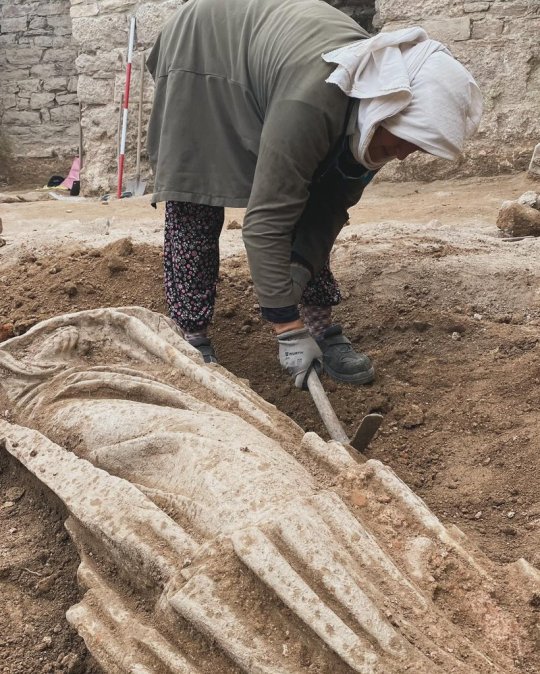
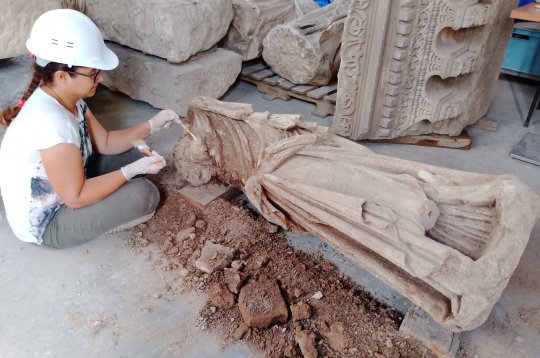

The statue and pedestal were found during excavations inside the frigidarium of the Roman bath in Stratonikeia. However, the head and arms of the sculpture were notably absent from the findings.
Previously, a replica of this revered statue was discovered in the Roman baths of the ancient city of Perge, as well as another in Rhodes, demonstrating its widespread replication during the Roman period.
The statue will be exhibited at the Muğla Museum after the work to be done.
By Oguz Buyukyildirim.

#A 2175-Years-Old 'Dancing Moses' Statue Discovered in Turkey#Ancient City of Stratonikeia#Philiskos#marble#marble statue#marble sculpture#ancient artifacts#archeology#archeolgst#history#history news#ancient history#ancient culture#ancient civilizations#roman history#roman empire#roman art#ancient art
48 notes
·
View notes
Text
Which are stronger, rules or precedents? (Roman Republic #4)
We’ve been looking at the disintegration of the Roman Republic so far as part of a project where we think about what happens when systems are tested and ways of life come to an end. Today, we’ll look at which are stronger -- rules or precedents set by those who break them.
Last time, we looked at a Roman politician named Marius, who was at the peak of his powers around the year 100 BCE. Marius was a populist reformer whose bending and breaking of the norms of Roman government were overlooked because of a military emergency and his promises to combat economic inequality in Rome. Marius was incredibly popular among the ordinary citizens of Rome, but his challenges to the traditions of Roman society would not be ignored by those who wanted to protect their privileged places in that society.
Marius sort of retired from Roman life after being consul in the year 100. The ancient sources differ on what happened to him over the next decade or so. Some sources say that he was basically banished from the city of Rome in humiliation and spent years desperately trying to find ways to get back into power. But I think it's more plausible that he retained a lot of his popularity, operating as an influential figure just offstage of the Roman drama. While he was out of politics, others of course rose to prominence. The most important of these people was a man named Sulla, who rose to prominence during a war called the Social War. In this strangely named war (called this after Rome’s allies, the socii, who had revolted against Rome all over Italy), Sulla was awarded the top generalship over Marius by Senators who had had enough of Marius’ populist reforms. As he ascended to the heights of Roman politics, he and his oligarchic allies in the Senate began to look for ways to undo some of the reforms that Marius had made. But first, he prepared to take his army east to conquer Pontus, a Greek kingdom in modern day Turkey.

Sulla (https://en.wikipedia.org/wiki/Sulla#/media/File:Bust_of_Sulla_(loan_from_Ny_Carlsberg_Glyptotek)_-_Glyptothek_-_Munich_-_Germany_2017.jpg)
Seeing this and fearing that Sulla would get too powerful, Marius pulled strings to get himself made the commander of the invasion of Pontus. This decision was made by the people’s assembly, not the Senate, and when the Senate (a more conservative body of Rome’s most powerful and rich men) tried to undo the decision, senators were basically impeached from their offices. The senators tried to have Marius' allies killed (as they had killed the Gracchus brothers 40 years earlier), but the populists organized a bodyguard of gladiators to fend off the attacks. When messengers were sent to Sulla to tell him that Marius had gotten command of the army, Sulla’s men stoned the messengers to death and then marched on Rome, justifying this as a rightful response to Marius’ challenges to the mos maiorum, the traditions of Rome.

The kingdom of Pontus (https://www.shorthistory.org/ancient-civilizations/ancient-rome/first-mithridatic-war-and-the-role-of-lucius-cornelius-sulla/)
Sulla’s army crushed the force of gladiators that Marius and his allies had organized to defend Rome and then marched into the city of Rome in violation of long held tradition that Roman armies must never enter the city. Marius and his allies were declared traitors, and Marius fled, while Sulla took his army to Turkey to fight the war against Pontus. Marius took advantage of the absence of Sulla to get elected consul one last time after marching his own army on the city and killing many of Sulla’s allies. Then Marius died of old age after having held office for 17 days.
After winning the war in Turkey, Sulla marched his army back into Rome, killing many of those who had betrayed him to support Marius. The conservatives in the Senate made him “dictator for settling the constitution.” He used his dictatorship to purge Rome of thousands of people who he deemed too radical and to pass a number of laws turning governmental norms that he and others bent or broke into hard and fast rules. He basically tried to prevent anyone in the future from doing what he had just done — use command of an army and personal popularity to gain absolute power in Rome. Sulla did retire and died soon afterward, and may have died thinking he had solved Rome’s problems through swift and decisive action.
But which lesson do you think young politicians like Julius Caesar, who had to run and hide from Sulla’s purges, learned from Sulla? That they should never break the laws that he put in place? Or that if, like him, they could put together enough connections within Rome’s elite and get command of an army that was personally loyal to them, they could have absolute power over the richest empire the Mediterranean had ever seen? I think you know the answer to that question.
{HTE}
9 notes
·
View notes
Text
Best 10 Places to Visit
Istanbul
Nearly all Turkey itineraries begin in Istanbul. It’s this city that straddles two continents at once. The Bosphorus Strait acts like a continental border, splitting the city into two halves Napa wineries European and Asian. This city is the center of the country’s film and television industry, which is why many telenovelas, including Kuzey Guney, are not only shot but also set here. When here, make sure you visit the Ottoman Topkapi Palace, the beautiful Hagia Sophia with its intricate mosaics, and the underground Basilica Cistern. Shop until you drop at the Grand Bazaar, take a cruise down the Bosphorus, say a prayer at the Blue Mosque and soak in the cityscape from the Galata tower.
Ankara
Turkey’s capital and second-largest city, Ankara, is a quieter version of Istanbul. Buğra Gülsoy, who plays Guney in Kuzey Guney, was born here. He is among many celebrities who call this city home.The city has all the fine-tuning that come with being a diplomatic seat of power; however, it never bores its visitors. Here, you can visit the Anıtkabir, which is the mausoleum of Mustafa Kemal Ataturk, the founder of Turkey. It is no wonder why this structure dominates the city’s skyline. For panoramic views of the city, head to the Ankara Citadel located in the Ulus Bentderesi District of the Old Quarter. While you are here, go for a walk on the cobblestone alleys of the quarter and take in the quaint Ottoman houses. At the other end of the spectrum is Kizilay Square, filled with buzzing cafes and restaurants.
Bodrum
The star of the Turkish Riviera, Bodrum, is a world-famous getaway for beach lovers. The city sits by the Aegean Sea and offers a fun Mediterranean vibe to visitors. Its enviable location makes many tourists throng the numerous cafes, restaurants, and luxury hotels that line its azure coastline every summer. Kıvanç Tatlıtuğ, who plays the role of Kuzey in Turkey’s most popular show, holidays here often! You could visit Bodrum Castle, the Museum of Underwater Archaeology, the ancient Bodrum Theatre, and Myndos Gate or simply recline on the beach and hope to run into him!
Kas, Antalya
Kas is a quiet seaside town set away from the bustling crowds. It is located in the Antalya region on the Mediterranean coastline of Turkey. If you prefer an itinerary that’s void of a to-do list, this should be your to-go place! This is the best spot to explore the underwater world first-hand with several diving schools that will first train and then take you on guided deep-sea diving tours. You may take a break from that at one of the seaside cafes or explore the colorful streets of the old market! Kas also offers a dose of history in the form of ancient sites like Antiphellos Theatre.
Trabzon
Trabzon offers two-in-one fun: it’s located by the Black Sea in north-eastern Turkey and has the Pontic Mountains pass through it; this creates a hill station-like ambiance. The region offers a different take on Turkey, one that’s sprinkled with bouts of silence. Explore the Sumela Monastery, a Greek Orthodox Ministry built in the year 346 AD. Spend a night near the Uzun Göl or Long Lake, enjoy a sunset over the Black Sea at Boztepe, and pay respects to the nation’s founding father at the Trabzon Ataturk Kosku museum. Trabzon also has its own Hagia Sophia that’s a little different from the one in Istanbul!
Cappadocia
You will know you’re in Cappadocia when you look up and see colorful hot air balloons floating in the sky. Of course, the best view from one of these balloons is that of the UNESCO World Heritage Site-listed Goreme Open Air Museum, which is home to rock-cut churches that once sheltered Byzantine monks. Equally fascinating are the region’s 36 underground cities—; the most prominent one being the Kaymakli Underground City. Once you’re done touring the sights in Istanbul and Ankara, there are direct flights that connect you to this city in the central Anatolian region of Turkey. You can visit the various pottery shops, the Pasabag, and Devrent Valley, and even check into a cave hotel!
Ephesus
If you are a lover of history then Ephesus must make an entry in your Turkey travel map. It is located about one hour away from Izmir, a city in which many of Turkey’s most popular shows have been set. Ephesus was once an ancient Greek city and today its ruins are very interesting to visit. The entire area is now a UNESCO World Heritage Site, and its must-visit places include the remains of the Temple of Artemis, the Temple of Hadrian, the Basilica of St. John and the Ephesus Museum where you will be captivated by the Artemis statute and the Gladiator Room. The Isa Bey Mosque is an important religious center as is the Meryemana.
Konya
Konya is a romantic city—the kind that would lure dreamers and poets. It’s no wonder why the famous Sufi poet and whirling dervish, Mevlana Rumi, penned his famous, heart-touching verses here in the 13th century. Without a doubt, your first stop should be at the Mevlana Museum that’s adorned with gorgeous roses and contains the tomb of the renowned poet. Its Semahane contains a museum exhibiting religious items from the era. Head to the Alaeddin Tepe park for an evening stroll and cup of Turkish tea. The other fine arts in Konya are represented by the Tile Museum and Museum of Wooden and Stone Carving, ensuring that all lovers of art have a gala time here!
Pamukkale
Pamukkale literally translates to “cotton castle.” One look at its whitewashed terrain and you will know why! The natural site in southwestern Turkey abounds with hot springs rich in the mineral travertine and has been drawing visitors since the 2ndcentury B.C.! Declared a UNESCO World Heritage Site, Pamukkale combines mineral forests, waterfalls, and terraced basins into an open-air spa in a surreal landscape. Take a dip in the calcium-rich travertines, trek up Pamukkale Castle, and learn about Cicero in the Roman ruins of Laodikeia. You may also explore the Hierapolis City Ruins that, along with the springs, make up this UNESCO site.
Bursa
Bursa is so verdant that it was nicknamed "Yeşil Bursa" (Green Bursa) because of the number of parks and gorgeous mountain within and around it. It once served as the capital of the Ottoman state, and its importance as an industrial center continues to this day. In the winters, it is a major attraction for skiers because of the ski resort of Mount Uludağ that overlooks it. In the summers, the mountain provides respite from the heat and wonderful mountain vistas. Take the teleferik to go up to the top. Cumalıkızık, with its quaint cobblestone streets, is a preserved Ottoman village just outside the city center that offers a peek into the traditional Turkish way of life, head here for its huge village breakfast spreads. Buy souvenirs like ebru painting, lithography, ceramics and tiles, calligraphy, metal art, and Ottoman-period antiques at the Kayhan Bazaar. Also, don’t miss the natural thermal spas and hammams!
1 note
·
View note
Text
The Once-Extinct Aurochs May Soon Roam Europe Again
After a decade, scientists are getting close to bringing back the massive wild cattle.
— Gastro Obscura | By Diana Hubbell | January 26, 2022
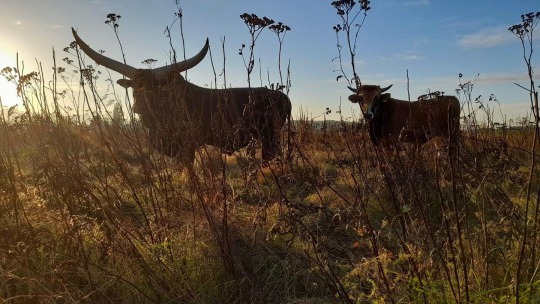
Part of the breeding herds from the Auerrind Project. Photo Courtesy of The Auerrind Project
When the Swedish armies descended upon Poland in 1655, they laid waste to the kingdom and pillaged whatever they could. Among the spoils stolen from the city of Jaktorów was one of King Sigismund III’s most prized possessions: an ornate drinking horn, longer than a grown man’s arm and as thick as an elephant tusk. Although the artistry was exquisite, the horn’s true value had little to do with the metal wrapped around its circumference. In life, the horn had belonged to the last aurochs bull, who died in 1621.
Today, the horn, which resides in Stockholm’s Royal Armoury, is one of the few surviving remnants of the wild cattle that roamed Eurasia and North Africa for more than 250,000 years. Like so many of Europe’s megafauna, the aurochs met their end at the hands of humans. Their horns were such coveted hunting trophies that by the Middle Ages, their numbers had already fallen. The species officially went extinct in 1627, when the last cow died in Poland.
Standing six feet tall and weighing more than 3,000 pounds, with horns more than 4.5 feet from tip to tip, these mighty herbivores were once a sight to behold. Paleolithic people painted them on the walls of caves around the region. The Celts associated them with Cernunnos, a god of the underworld. The ancient Romans pitted their finest gladiators against them. “These are a little below the elephant in size, and of the appearance, color, and shape of a bull,” wrote Julius Caesar in Commentarii de bello Gallico. “Their strength and speed are extraordinary; they spare neither man nor wild beast which they have espied.”

Ancient cave paintings in Lascaux, France, depicting aurochs. Getty Images/ DEA/C. Sappa
For more than a decade now, scientists have been seeking to bring back this keystone species—and they’re getting close. While the aurochs themselves may be gone, their genes live on in most modern European cattle breeds. Somewhere along the way, our Neolithic ancestors in Iran and what is now Turkey managed to domesticate aurochs, rather than simply hunt them for food. The Chillingham white cows of northern England, the Spanish fighting bulls of the Iberian Peninsula, and the Chianina of Tuscany all carry substantial portions of their DNA. Since 2008, the Tauros Programme in the Netherlands has been working to back-breed aurochs. The Auerrind Project, which launched in 2013, currently has five breeding herds in Germany. Both organizations share research and, occasionally, breeding stock.
“Looking at the calves from this year, especially the bulls, they have a lot of potential,” says Claus Kropp, a trained archeologist and leader at the Auerrind Project. “We’re really on the right track. If we continue a careful selection for the next 10 years, we could potentially have a stable population by then.”
Indeed, the third generation of animals currently grazing in southwestern Germany look an awful lot like their Neolithic predecessors. The largest of the bulls clocks in at just shy of six feet and more than 2,200 pounds, with horns that rival those ancient skulls in size. Most of the bovines in question are a mix of Sayaguesa, Watusi, Hungarian steppe cattle, Maremmana, and Chianina genes.
Fortunately, the Auerrind Project has a large amount of data on the animals they are striving to recreate. Extensive written documentation and illustrations paint a clear picture of the size and appearance of Europe’s aurochs. Along with historical records, the Auerrind Project has the fully sequenced DNA of three aurochs. Thanks to data obtained by DNA testing bones at the University of Kiel and radiocarbon dating of bone material found in the Upper Rhine Valley, the scientists even have a sense of the genetic variations in different regional populations of aurochs.

Thando, a pure Watusi breeding bull. Photo Courtesy of Claus Kropp
“We know the DNA of this animal and we can compare that with the modern-day cattle DNA, which can yield some pretty surprising results,” Kropp says. For instance, the Holstein, otherwise known as the humble dairy cow, shares about 95 percent of its DNA with an auroch. With older breeds, that percentage is even higher. “The distance from the aurochs to the Pajuna cattle from Spain is just 0.12 percent, so there is more than a 98 percent overlap.”
Genetic distance isn’t the only factor when it comes to successful back-breeding; scientists also have to look at phenotypic traits. A number of heritage cattle breeds still visually resemble aurochs, even if none is a perfect match. For instance, those Spanish Sayaguesa cattle are a dead-ringer when it comes to coloring, but have the wrong horn size, while the Italian Chianina boast enormous horns, but with shaggy, white coats.
“When you take all the breeds that are supposedly close from a genetic side, but also from a phenotypical point of view, you have a chance to maybe get to results in quite a fast amount of time,” Kropp says. Speedy results in genetic terms translates to years, given that a pregnant heifer spends 10 months gestating. Still, that’s soon enough to start considering the potential ramifications.
Bringing species back from extinction is often a contentious business. It’s also an increasingly urgent topic, given that most experts believe we’re living through a mass extinction. By some estimates, human negligence robbed us of half the earth’s biodiversity in the last half century.
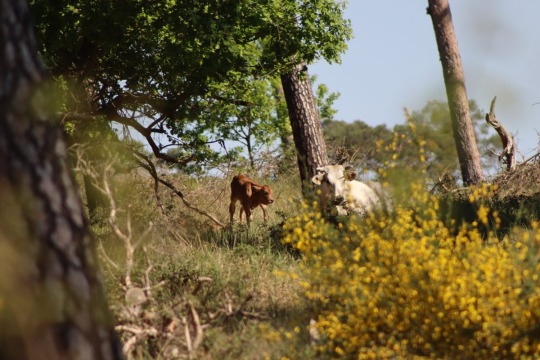
A mother and calf from the Auerrind Project. Photo Courtesy of M. Thumm
The Auerrind Project and the Tauros Programme are far from the only organizations trying to bring back species from oblivion. Last year, a startup called Colossal scored $15 million in initial funding to try and bring back wooly mammoths using CRISPR technology. The Australian Lazarus Project has been focusing on a species of frog that birthed its young through its mouth, while the Passenger Pigeon Project hopes to bring back the birds that were once so numerous that their migration once blocked out the sun. Ever since scientists genetically sequenced the Tasmanian tiger, which died out in 1933, using a set of teeth in the Australian Museum, they’ve been talking about trying to clone them back to life.
Much like with still-living endangered species, time and financial resources in de-extinction often go towards charismatic megafauna. Yet Kropp and his colleagues insist that their focus on aurochs isn’t simply because they’re, well, cool. In contrast to cloning mammoths and other species, back-breeding programs are decidedly lower in risk. For one thing, there is no danger of reawakening ancient pathogens. For another, scientists have little concept of how the Tasmanian tiger or wooly mammoth behaved; with no living populations to draw on, teaching herds of clones to survive in the wild is a daunting task.
More importantly, in ecological terms, aurochs haven’t been gone long enough for nature to fill the gaping hole left in their wake. Like their counterparts on the North American and African continents, large grazing herbivores such as European bison and aurochs played a critical role in biodiversity.
“A grazed landscape with large herbivores looks very different from a modern meadow from an industrial agricultural company,” Kropp says. The Auerrind Project has been closely monitoring both the flora and fauna in controlled environments with their bovines. “Even in these small environments, the biodiversity is exploding even within a couple of years. I don’t think it’s by chance that our first grazing site was the first sighting of the beaver again.”
“Even in these small environments, the biodiversity is exploding within a couple of years.”
Both the Auerrind Project and the Tauros Programme are part of Rewilding Europe, a nonprofit which has been reintroducing bison, lynx, elk, and wolves around the continent. Thanks in large part to the foundation’s efforts, European bison, which were once all but wiped out, have increased in numbers to more than 7,000 over the last decade. More than 12,000 wolves—more than in the United States—now inhabit Europe, including Iberian wolves in Portugal and Italian grey wolves in the Alps. At the core of the whole project is the European Wildlife Bank, which relies on large herbivores to restore habitats and usher in the return of other species.
“We often call grazers ‘landscape engineers,’ because they play a vital role in shaping landscapes and driving natural processes,” says Laurien Holtjer, head of communications at Rewilding Europe. By disrupting forest growth, these mammals created varied terrain, all the while fertilizing the ground and distributing seeds with their droppings. “The natural disturbance of large grazers in low, natural numbers play a pivotal role in restoring mosaics of vegetation [and] stimulating more biodiversity.”
But reintroducing large animals is not without its problems and pushback. Both politicians and farmers often resist rewilding and its inherent disruption. Wolves in particular have drawn all sorts of ire, despite clear evidence that they’re a boon to healthy ecosystems. In 2017, the first European bison to make its way into Germany in 250 years was almost immediately shot dead. Once a breeding population of modern-day aurochs exists, the challenge will be convincing humans to live with them. “With wildlife coming back, we also need to ensure that we learn again how to live with them,” Holtjer says. “And in such a way that people benefit from wildlife returning, for example through tourism and wildlife watching.”

Heck cattle in Oostvaardersplassen, the Netherlands. Getty Images/Arterra
“If you do it right, of course, coexistence can be possible,” Kropp insists. While the Auerrind Project’s breeding population is not meant for domestication, they’re going to great lengths to avoid creating animals that might attack humans. That’s why Spanish fighting bulls, which bear a striking physical resemblance to aurochs, aren’t in the mix.
Also noticeably absent in the Auerrind Project’s stock are Heck cattle, the striking, aggressive breed created in the 1920s by two German zoo directors, Heinz and Lutz Heck. Despite the lack of modern-day knowledge of genetics, the Heck brothers both claimed to have recreated aurochs through back-breeding. Heinz even wrote, “The wild bull, the aurochs, lives again.” Disturbingly, these early attempts at creating aurochs dovetailed with the fascist politics of the time. Lutz in particular, who was a member of the Nazi Party, convinced Hermann Göring that the return of ancient European beasts like aurochs and tarpan, or wild horses, fit with the the National Socialist Party’s ideological push to recreate an imagined European past.
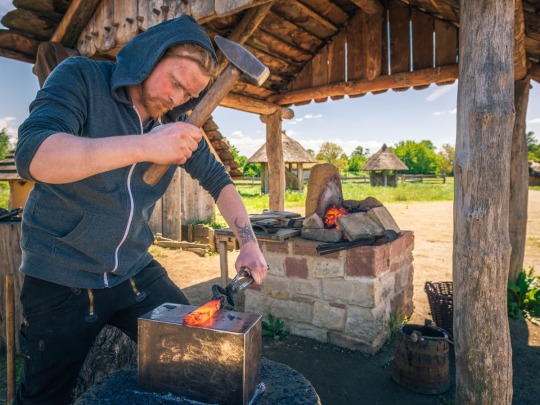
Educating the public at the Lauresham Laboratory for Experimental Archeology. Phot Courtesy of M. Thumm
Genetically speaking, the Heck cattle are still a far cry from aurochs. A small number of their surviving descendants can be found in Oostvaardersplassen, an experimental rewilding area in the Netherlands. Both Dutch and German scientists are, understandably, quick to distance any current efforts from this dark period in European history. Back-breeding any species is not about misguided attempts at nationalism, but rather about an attempt to restore balance to environments devastated by humans.
“What is unique to our project is that we’re coming from that museum background,” Kropp says. “We have a strong viewpoint on the educational side. We want to inform the public why these large herbivores play an important role in these ecosystems.”
So far, the Auerrind Project’s efforts at promoting ecotourism are going well. Since the project is connected with the Lauresham Laboratory for Experimental Archeology in the UNESCO Global Geopark Bergstraße-Odenwald, part of its mission is to showcase what a Medieval European landscape would have looked like. On guided cycling tours, visitors have the chance to see some of the ecosystem that was all but lost.
“It’s not hard to impress people when you have these really large bulls in front of you,” Kropp says. Most of these gawkers have never experienced the sense of wonder that the presence of these giants evokes. “You actually have that safari feeling. It’s something they wouldn’t expect from our landscapes anymore. You don’t see these really wild animals anymore. Most of our large herbivores and carnivores have been gone for so long.”
0 notes
Text
15 Most Famous Roman Bathhouses

Even though the most spectacular forms of entertainment in ancient Rome were gladiator fights in Roman Amphitheaters and chariot races in huge stadiums, another popular pastime for Romans was spent quite differently.
These Roman bathhouses were a lot more than merely a facility to take a bath. Many of these large-scale complexes included places to socialize or work out, and some even featured a library.
Just about every ancient Roman city had at least one "Thermae" or "Balneae," so the people living there could unwind. Thermae s the name used for huge bathing complexes while Balneae is the name of smaller, public, or even private facilities.
Let's take a closer look at some of these remarkable structures of which the ruins are today scattered all over parts of Europe, Africa, and Asia.
1. Baths of Caracalla - Rome, Italy
The Baths of Caracalla were named as such in honor of the Roman Emperor Caracalla (188-217 A.D.), the man who was in charge when the baths were completed.
The construction already started during the reign of his father Septimius Severus, most probably between 211 and 216 A.D. (even though the exact dates are uncertain).
Even though the construction period of 5 years seems like a lot, this facility in Rome was enormous. It's was to be the second-largest bathing complex ever constructed in the Roman Empire.
The building had a height of approximately 40 meters (130 feet) and the baths had a volume of 8 million liters (2.1 million US Gallons).

The Baths of Caracalla / Ethan Doyle White / https://creativecommons.org/licenses/by-sa/4.0/deed.en
2. Baths of Diocletian - Rome, Italy
The Baths of Diocletian were built around a century later in a construction project that lasted between 298 and 306 A.D. These were built during the reign of Emperor Diocletian, infamously known for his horrible persecution of Christians during the early 4th century.
Remarkably, Diocletian neither commissioned the baths in Rome as his predecessor Maximian did nor did he reign when they were completed (he voluntarily resigned).
During this period, the largest ancient Roman bathhouses were completed, capable of holding approximately 3,000 bathers at any given time. Just like the Baths of Caracalla, they were operational until the aqueducts that supplied these structures were destroyed in 537 A.D.
Today, part of the bathing complex was transformed into a church called the Santa Maria degli Angeli e dei Martiri. This church was designed by Michelangelo in the 16th century and remarkably built inside the ruins of this bathhouse.

Baths of Diocletian / Anthony M / https://creativecommons.org/licenses/by/2.0/deed.en
3. Roman Baths - Bath, England
What are the odds that the city of Bath in Somerset, England, was named after the Roman Baths that are located here, right? Well, it was, and this ancient Roman bathing facility has been remarkably well-preserved as well.
This is especially remarkable because they were around 60-70 A.D., the first few decades of Roman rule in Britain. They also remained operational until the final years of Roman rule in the 5th century A.D., quite an amazing track record.
Just a century later, the baths lay in ruins and were gradually rebuilt during the Middle Ages. The facility consists of 4 sections today, including the Sacred Spring, the Roman Temple, the Roman Bath House, and a museum with Roman artifacts.
It's one of the most popular tourist attractions in the region and receives well over 1 million visitors every year.

The attraction in Bath / Diliff / https://creativecommons.org/licenses/by-sa/3.0/deed.en
4. Trier Imperial Baths - Trier, Germany
The modern-day city of Trier in the southwestern part of Germany was once one of the largest cities of the Roman Empire. After Diocletian reformed the EMpire, it became the city that oversaw much of the Western Roman Empire.
At its peak in the 4th century, it's estimated that the city of "Augusta Treverorum" had a population of anywhere between 75,000 and 100,000 inhabitants, which obviously meant it had all the facilities needed to entertain these people.
This also meant that the Imperial Baths of Trier and the nearby Barbara Baths were some of the largest built outside of Rome, even though only a fraction of the complex remains today.
Together with the Moselle Bridge, the Porta Nigra, and the Amphitheater, they are included in a list of 9 monuments in the city of Trier as a UNESCO World Heritage site.

Trier Imperial Baths / Berthold Werner / https://creativecommons.org/licenses/by-sa/3.0/deed.en
5. Thermes de Cluny - Paris, France
The Thermes de Cluny are other thermal baths located in Lutetia, the Roman name of Modern-day Paris. These are situated right in the heart of the city in the 5th arrondissement.
Not too much is known about the construction of these baths but it's assumed they were built in the first part of the 3rd century A.D. The remains of today are about 1/3 of the original bathing complex.
What's remarkable is that part of this complex has been incorporated into a modern-day attraction called the "Musée national du Moyen Age," which translates to the "National Museum of the Middle Ages."
This means that you can admire medieval artifacts right inside what used to be a Roman bathhouse, which is definitely quite amazing.

Inside the frigidarium / Traumrune / Wikimedia Commons / CC BY 3.0
6. Baths of Antoninus - Tunis, Tunisia
The Baths of Antoninus were the largest Roman Bathhouse built on the African continent. It was constructed in one of the most important cities of the Roman province of Africa, Carthage, just east of Lake Tunis in the modern-day capital of Tunisia.
The baths were constructed during the reign of Antoninus Pius between 145 and 162 A.D., not too far from the presidential palace of Tunisia today.
The complex was built at a monumental scale because Carthage was one of the most important trading hubs in the Mediterranean. By the third century A.D., Carthage was one of the biggest cities in the Roman Empire with hundreds of thousands of inhabitants.
The ruins of the baths are part of the Archaeological site of Carthage, a section that was declared a UNESCO World Heritage site as early as the year 1979.

Antonine Baths in Tunisia / Dennis Jarvis / https://creativecommons.org/licenses/by-sa/2.0/deed.en
7. Roman Thermae of Maximinus - Braga, Portugal
The northwestern part of the Iberian peninsula was part of the Roman province of Gallaecia, which in turn was part of the larger Roman region called Hispania.
The capital of this province was Bracara Augusta, a city today known as Braga in the northwest of Portugal. Just like any other provincial city of the Roman Empire, its city featured a bathing complex known as the Roman Thermae of Maximinus.
The original version of the complex was constructed in the second half of the 1st century B.C. It was completely remodeled in the 3rd century A.D. and a theater was added nearby as well.
It was built on top of a hill in the city, and even though many parts of the structure have been excavated, the complete plan of the structure remains unknown, quite remarkable for a facility that was operational until approximately the 5th century.

The excavation site in Braga / Joseolgon / https://creativecommons.org/licenses/by-sa/4.0/deed.en
8. Baths of Ancyra - Ankara, Turkey
The Baths of Ancyra were located in the modern-day city of Ankara, the capital of Turkey. They were but on the ancient city of Ancyra which was the capital of the Roman province of Galatia.
This city gained importance because of its strategic location as the Roman Empire expanded to the east. That's why this massive bathing complex was built in the early 3rd century A.D. during the reign of Emperor Caracalla.
The ancient entertainment venue was uncovered during a large excavation project that was conducted between 1937 and 1944. This really uncovered the scale on which this complex was built.
The wrestling court or "palaestra", which is the first part you'll visit at this huge open-air museum, was surrounded by a total of 128 large marble columns, something that tells you everything about how monumental this complex really was.
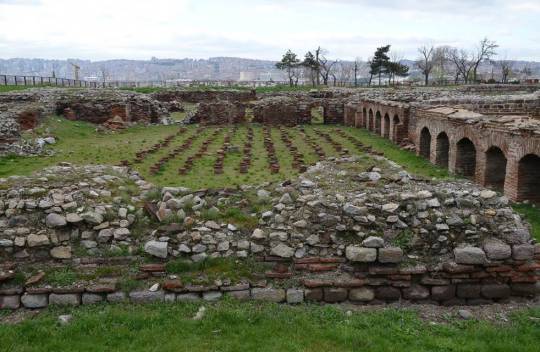
Remains of the Baths of Ancyra / Carole Raddato / https://creativecommons.org/licenses/by-sa/2.0/deed.en
9. Op de Thermen - Maastricht, Netherlands
Even though nothing about this public square in the Dutch city of Maastricht called "Op de Thermen" would initially make you assume that this was the location of an ancient Roman bathing complex, the name does hint at it.
That's because "Op de Thermen" literally translates to "On top of the Thermae" which refers to the fact that the square was built on top of the ruins of this Roman facility.
The surprising discovery was made during the 1840s when digging for a cellar in the area uncovered the remains of an ancient structure. It was quickly determined that these were the remains of a bathhouse dating back to the 2nd century A.D.
The entire complex was uncovered during an excavation conducted between 1963 and 1965. This determined that the complex had a length of about 40 meters (131 feet). Today, the square feature markings showing the size of the bathhouse below.

The square with the bathhouse below it / Kleon3 / https://creativecommons.org/licenses/by-sa/3.0/deed.en
10. Roman Thermae - Varna, Bulgaria
The Roman Thermae in Varna in the northeastern part of Bulgaria is another ruined complex located within the limits of a modern-day city. Varna is situated near the Black Sea and is an important port city in the country.
This ancient Greek city only became part of the Roman Empire in 15 A.D. and wasn't as important as many other cities on this list. This just emphasizes the extent of the development of all parts of the Roman Empire.
The city was part of the Roman province of Moesia and the bathing facility was constructed near the end of the 2nd century. Unlike many other structures, they were only in use for about a century and already fell into ruin in the late 3rd century.
This makes it all the more surprising that these baths are considered to be the 4th-largest Roman baths ever built in Europe, covering an area of about 7,000 square meters (75,000 square feet).

The ruins in Varna / Anton Lefterov / https://creativecommons.org/licenses/by-sa/3.0/deed.en
11. Baths of Trajan, Rome Italy
The Baths of Trajan were another large complex of structures that were constructed during the early 2nd century. They were commissioned by Roman Emperor Trajan and completed between 104 and 109 A.D.
The complex was built on the southern slope of Oppian Hill which was situated on the outskirts of Rome back then. Just like many other Imperial baths, they served as a social gathering spot for Roman citizens.
Bathing wasn't the only thing you could do here because it also featured a gym and two libraries, one in Latin and one in Greek. The baths eventually fell in disuse in the early 5th century.
Not much remains of this huge structure today, but the southwestern exedra which housed both libraries of the complex still stands, quite an intriguing sight.

The library of the Baths of Trajan / Rabax63 / https://creativecommons.org/licenses/by-sa/4.0
12. Roman Berytus - Beirut, Lebanon
Even though Beirut in Lebanon is a city with a lot of history, it's also a modern sprawling city with modern architecture. This makes it all the more surprising that right in downtown Beirut you can find the ruins of a Roman bathhouse.
This ancient complex, of which only ruins remain, are surrounded by government buildings and was only discovered in the late 1960s. The archaeological site was seriously renovated during the 1990s and is now a popular attraction in the city.
This isn't the only bathhouse that was created here, though, as the city featured 4 of these complexes, 1 of which as constructed during the reign of Emperor Augustus in the late 1st century B.C.
The main reason why the baths in Berytus were destroyed was because of an earthquake that happened in the year 551 A.D.

Roman Baths in Beirut / Shell / https://creativecommons.org/licenses/by-sa/2.0/deed.en
13. Taurine Baths - Civitavecchia, Italy
A huge bathhouse was built just outside of Rome in a city known today as Civitavecchia. These baths are referred to as the "Taurine Baths" and date back to the Republican era of Rome in the 1st century B.C.
The name of the baths refers to a town just nearby that doesn't exist anymore called "Aquae Tauri." Even though the original baths were rather humble, they were greatly expanded during the reign of Emperor Hadrian in the 2nd century A.D.
This complex was operational from its establishment in the year 86 B.C. until the 6th century when most aqueducts in the area were destroyed by the Goths.
Just like many other Imperial bathing complexes, this one featured a wide variety of other entertainment facilities, including a library and other spaces for Romans to socialize.

The hot pool at the Tuarine Baths / MM / https://creativecommons.org/licenses/by-sa/4.0/deed.en
14. Badenweiler Baths - Baden-Württemberg, Germany
Baden-Württemberg is the German version of the city of Bath in England, mainly because the town was named after the ruins of the Roman bathing complex that is located here.
The ruins of this complex are considered to be some of the best-preserved north of the Alps and are a major tourist attraction in this upscale Spa resort in the southwest of Germany.
The layout of the bathing complex was retained and the floors inside the hot and cold swimming pools are still the original ones which is quite amazing.
The region is renowned for its hot springs, and when the bathing complex was rediscovered in the late 18th century, the tradition of bathing was reintroduced int he region as well. Neoclassical bathing complexes replaced the ancient ruins of the Roman Empire.

Badenweiler Baths / PaulT / https://creativecommons.org/licenses/by-sa/4.0/deed.en
15. Hammam Essalihine - El Hamma, Algeria
While the towns in Germany and England have turned their ancient ruins into a modern-day facility and tourist attraction, the people in Algeria had something completely else in mind.
At Hamman Essalihine, the ancient Roman bathing complex was partially renovated and still serves as a swimming pool today, just like how it was nearly 2,000 years ago.
The name of this Roman bathhouse translates to "The Bath of the Righteous" but was originally known as the "Aquae Flavianae." This is a reference to the Flavian Dynasty that ruled over the Roman Epire during the late 1st century A.D.
Yes, this complex in modern-day Algeria was built around the same time as the Colosseum in Rome and is still active today, simply astounding!
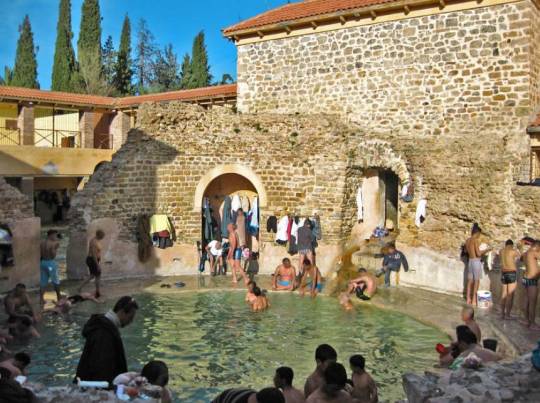
Aquae Flavianae Khenchela / Ghezal Tarek / https://creativecommons.org/licenses/by/2.0/
Read the full article
1 note
·
View note
Text
An Exploration of Architecture in the Mediterranean - ARH2050 Final Project
Throughout all ages, people have been constructing buildings dedicated to that which they believe to be divine. This theme is especially prevalent in the Mediterranean and the empires from this region, as they span over thousands of years and cover a multitude of different areas. From polytheistic temples to monotheistic churches, there is no shortage of great architecture in the Mediterranean. While architecture in this region has made great leaps and bounds over the years, there still exists in each structure the desire to remain true to architectural conventions, coupled with the boldness of adventurous architects.
Perhaps one of the most impressive structures here, especially considering the time it was built, is the Palace Complex of Knossos in Crete. Constructed thousands of years before the birth of Christ, the Palace Complex is the oldest structure on this list, as it is believed to have been built as early as 2000 BC. This structure was not just a palace, but also acted as an all-purpose city center. The complex, in addition to serving as a building for the ruler of Minoa, provided citizens with a place to hold religious ceremonies, rooms to store products, and gave artists space within workshops. Minoa clearly held artists with high regards, as the walls of the complex are filled with beautiful paintings with superb compositions. Even though many of these paintings have been lost to time, we can see what artistic conventions were present in the Minoan society: Geometric borders, stylized forms, nature, and everyday human life.

The architectural ingenuity of the Palace Complex is something absolutely astounding, and holds up even by today’s standards. When viewed from the outside, the palace resembles a labyrinth. Walls and corridors, which were built on low areas of the island, stretched for six whole acres! Most of the walls of Knossos were made of precisely cut slabs of stone, or “dressed stone” which is not only a testament to the fine architecture of this complex, but also shows how advanced the Minoans were as a society. This claim can be further amplified by the fact that many of the walls were largely resistant to earthquakes due to the advanced construction capabilities yielded by the Minoans.
The Palace Complex wasn’t just thoughtfully designed on the outside, but on the inside the thoughtfulness of the architects is present as well. Inside the palace’s walls were large courtyards where people could gather. These courtyards were flanked by a variety of different rooms as well, with workshops and commercial centers being the most prominent, as trade played a major role in Minoan life.
The next structure we will be exploring is the Acropolis, in Athens, Greece. Among one of the most well known structures in the world, the Acropolis serves as a prime example for what it means for a work of architecture to be Greek. As opposed to the Minoan Temple Complex, the Acropolis was built on top of a hill instead of among hills. While not taking up the same magnitude as the previous structure, the Acropolis makes up for that with it’s impressive design elements and state of the art construction.
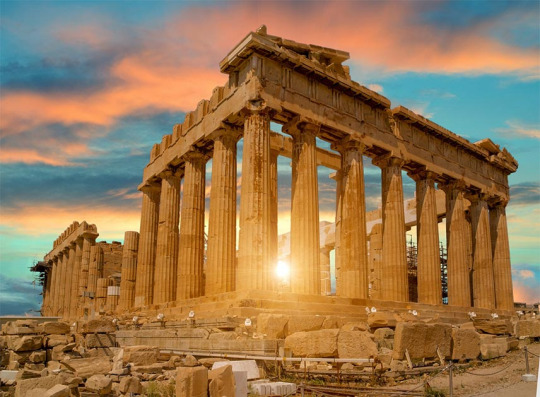
Like the Minoan Palace, the Acropolis was more than just a temple, as citizens could store goods and gather water there. Unlike the Palace Complex which was built as one interconnected super structure, the Acropolis takes a less imposing approach to it’s design. Built around a larger courtyard-like area, the Acropolis consists of a variety of different structures, the most recognizable of which being the Parthenon. The Parthenon is arguably the most important structure within the Acropolis, as it is the largest, and has elements that would persist in Mediterranean architecture for years to come.
The ancient Greeks valued geometry and order, which is evident when looking at the Parthenon. One example of this can be seen in the Parthenon’s most prominent aspect: it’s columns. Since straight horizontal lines appear to cave in at their center, the architects designed the columns to be slightly flared out towards the middle in order to create the illusion of a strong, consistent line throughout the entire column. Additionally, the Parthenon is based around a cella and peristyle, and is constructed in a rectangular shape.
Nearby in ancient Rome, we find ourselves at a structure that was dedicated to Titus, and was commissioned as a gift for the people of Rome by Emperor Vespasian: the Colosseum. While not a religious structure per se, gods and goddesses were honored within its walls through various types of sporting events, such as gladiator fights and animal hunts. When considering the Colosseum as an architectural feat, one must note that the Colosseum’s design which could hold around 50,000 spectators has yet to be improved upon, even after nearly 2000 years. Additionally, it is believed that the interior area where events took place could have been flooded with water, and turned into a maze in order to accommodate certain scenarios which were to be played out, such as hunting.

The Colosseum contains many bold architectural elements, the most noticeable of which being it’s many arches and vaults, and engaged columns. Arches and vaults existed thousands of years before the construction of the Colosseum, but ancient Rome was the first society to really use them to their full potential, as they were able to construct them faster and easier thanks to the invention of concrete. Just by looking at the Colosseum one can see that the majority of the structure’s support comes from it’s Arches and interior vaults. Since Vaults are lighter than solid walls, and can also bear more weight, this allowed for the Colosseum to be constructed as a freestanding structure of a great magnitude. The vaults also provided an entrance for sunlight to seep in; thus, illuminating the Colosseum. The Colosseum was also adorned with engaged columns. This aspect of the building’s composition was likely a direct result from ancient Greek influence. Though these columns provide no real structural support (as that is what the arches and vaults were for), they provide an extra layer of depth to the structure’s overall composition.
We find ourselves in Rome once more to explore yet another fine piece of architecture: the Pantheon. Regarded as one of the finest buildings in Rome and an architectural marvel of it’s time, the Pantheon was the direct result of what happens when you combine architectural genius with traditional styles. When viewed by an unsuspecting passerby, the façade of the pantheon takes the form of a traditional Roman temple. However, from the correct vantage point, one will see that it is not a traditional temple, but instead an engineering marvel. Never before had a dome been used to this scale.

As mentioned above, the Pantheon incorporates the elements of a traditional rectangular-shaped Roman temple in it’s façade. Large Corinthian columns stand tall, serving as a grand entrance for an even grander structure. Upon entering the Pantheon, onlookers are greeted by an amazing spectacle: a giant rotunda with a roof that ascends to the heavens. The architects of the Pantheon were able to achieve this effect through the employment of buttresses. By diverting much of the dome’s weight out and downwards, the builders were able to construct a dome bigger than anything that had previously been built.
The Pantheon was originally dedicated to Mars, Venus, and Julius Caesar, and took a period of 18 years to construct. Trajan, the emperor who commissioned the Pantheon to be built, clearly revered the three individuals who the building was designed for, as it is among one of the most technologically advanced structures ever created during that time. Everything from the oculus in the center of the dome, to the buildings glorious interior serve as a testament to the aspiration and inventiveness of the ancient Romans.
In the distant land of Turkey lies another architectural marvel: The Church of Hagia Sophia. Hagia Sophia means “Holy Wisdom”, and at the time, holy wisdom may have seemed like the only conceivable way humans could have constructed such a structure. It was even said that angels helped build the grand church, as it seemed like an impossible feat, especially when considering how it was built in only five years. When designing this church, absolutely no expense was spared. It’s two main designers were experts in physics and geometry who came together to form a structure which proclaimed the glory of God and the Byzantine empire. The amount of planning put into the Hagia Sophia, coupled with it’s many amazing features might even make one ponder why it is not one of the wonders of the world. It even had the largest dome of any structure in the world for nearly one-thousand years.
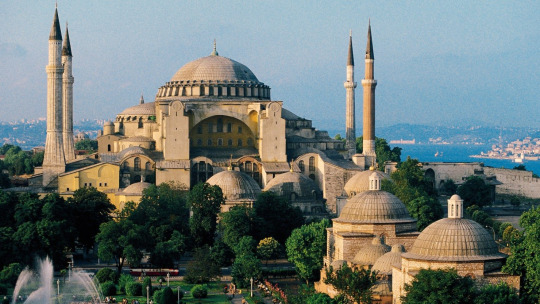
One cannot look at the Hagia Sophia without noticing it’s giant dome. Constructed in a similar fashion to that of the Pantheon, the dome of the Hagia Sophia when viewed from the inside looks nearly weightless, as if it is sitting on air. Like the Pantheon, the Church of Hagia Sophia uses buttressing to hold the weight of the dome. Additionally, pendentives and piers were used to hold up the structure’s massive dome in place. Since the Hagia Sophia is a mix between a central and longitudinal plan, the piers (rectangular or square supports capable of bearing heavy loads) submerge into the rest of the church instead of sticking out, allowing the architects to create the effect of the dome floating on air.
As mentioned earlier, the Hagia Sophia is a mix between the plans of a central and longitudinal church. Each type of plan has its own benefits, and the Hagia Sophia was able to capitalize on both. For example, the architects were able to incorporate long aisles along with overhead galleries: something that isn’t able to be done to the same extent in a central-plan church. The architects were also able to base the church around an overall geometric design, which not only makes the church feel even and symmetrical, but also natural to some degree.
Throughout all of history, the Mediterranean and it’s many different empires had no shortage of great and beautiful architecture. Architects were constantly taking inspiration from the works done before them, but also using their increasing knowledge of math and physics paired with a thirst for creativity to develop the world around them in new and groundbreaking ways. While much of the architecture in this region is very eclectic, there exists in each structure a special trace of individuality that simply cannot be replicated.
0 notes